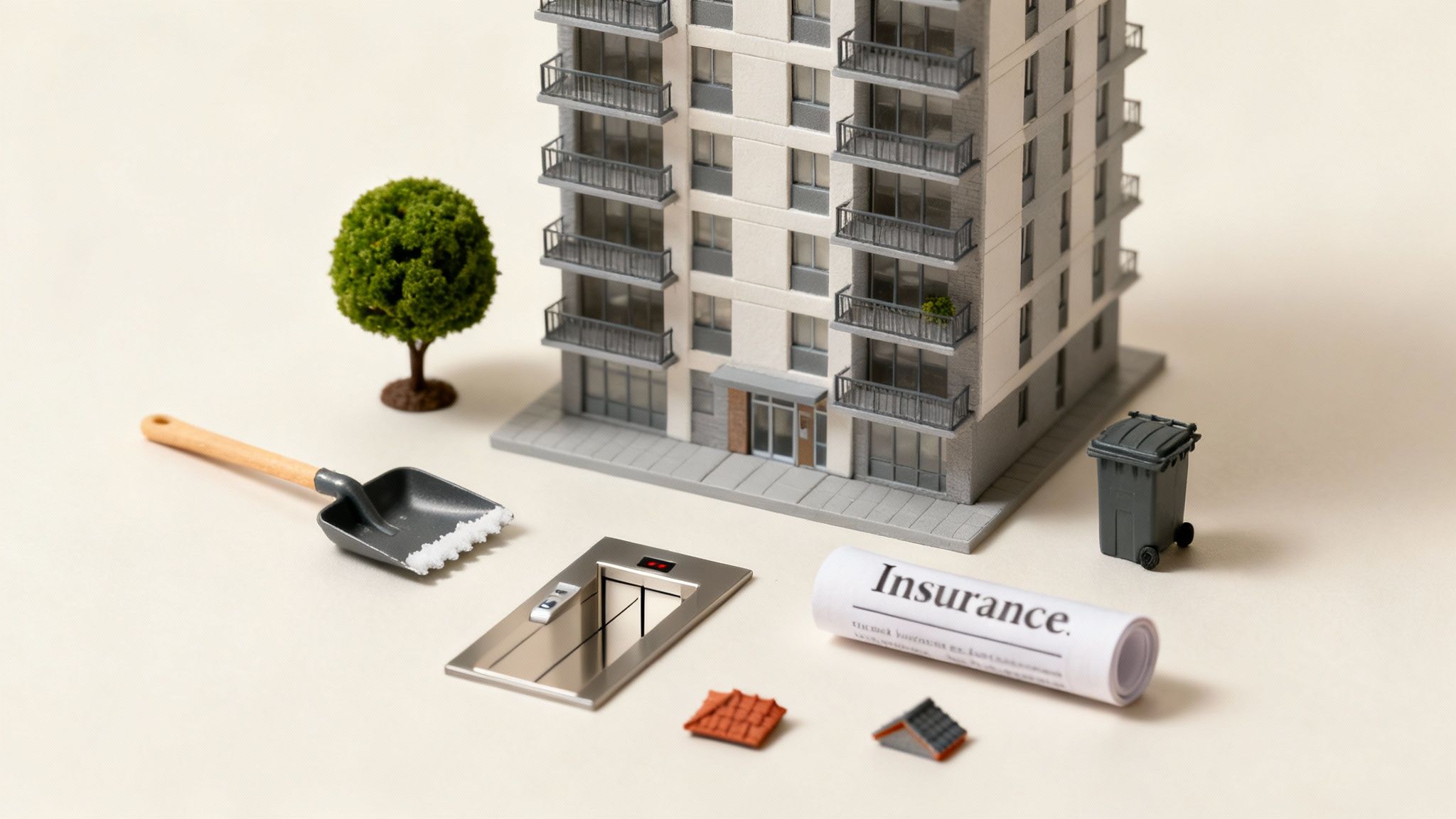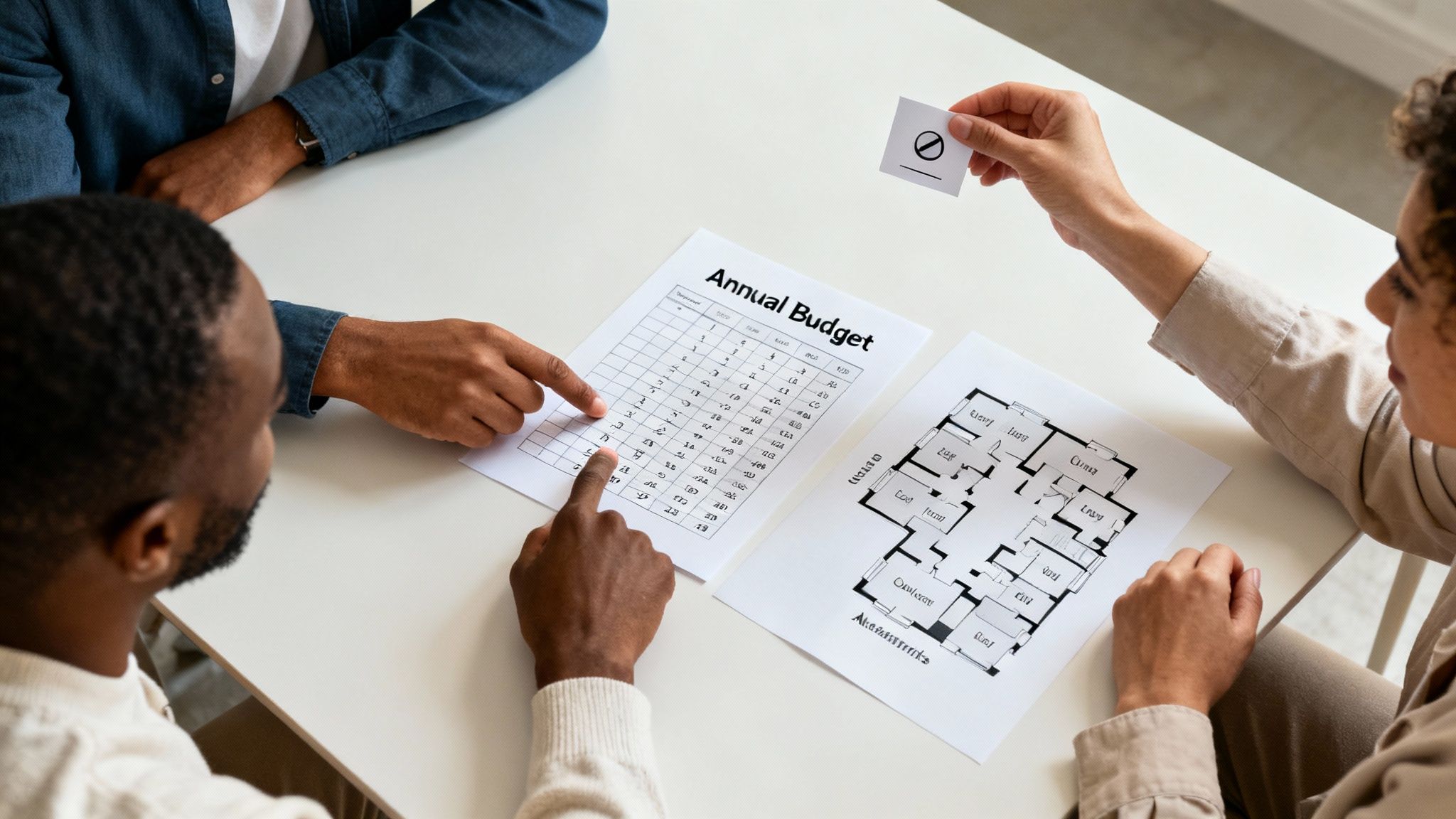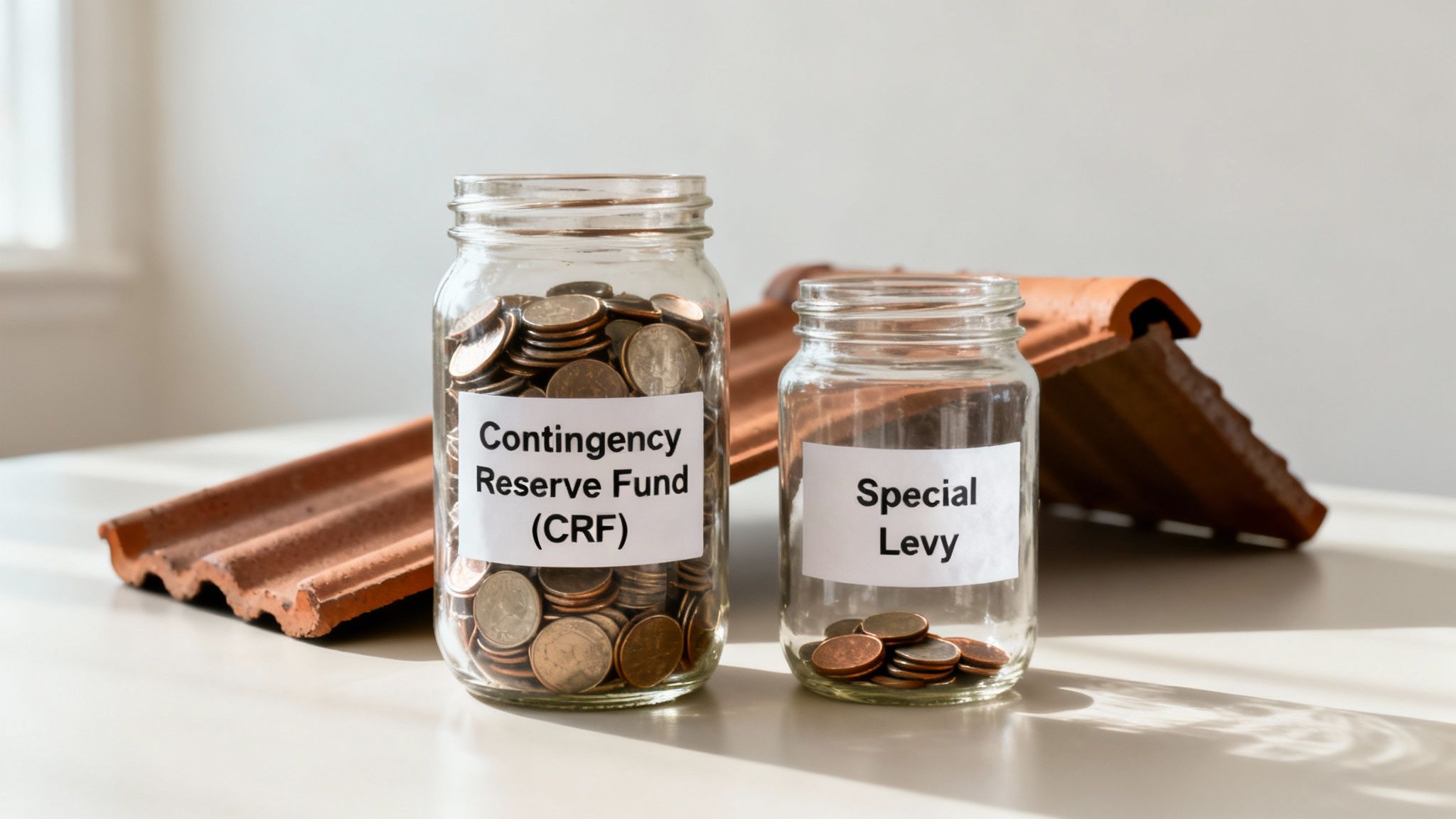What Is a Strata Fee in Kelowna? A 2025 Guide for Buyers
When you're browsing Kelowna homes for sale—especially condos and townhouses—you'll always see a 'strata fee' listed. If you’re scratching your head wondering what that is, you’re not alone. Think of it this way: a strata fee is your monthly contribution to a shared fund that covers all the maintenance and operating costs of the building and its common property. It’s teamwork for homeownership, and it’s a crucial part of your budget.
Understanding Strata Fees in Simple Terms

If you buy a detached house in Kelowna, you're on the hook for everything. Mowing the lawn, shoveling the driveway in winter, fixing the roof, and paying for garbage pickup—it's all on you. When you buy into a strata property, you share those responsibilities, and the costs, with all the other owners in the building.
The strata fee is your piece of that shared financial puzzle. It’s a predictable monthly payment that pools everyone’s money together to keep the property running smoothly and looking great. It's a key part of the Okanagan real estate market, especially in condo-rich areas.
The Team Analogy
Think of your strata corporation like a sports team where every owner is a player. The strata fee is your team contribution. It pays for:
The Gear: Keeping the building’s “gear” in top shape, like the roof, elevators, and plumbing.
The Field: Maintaining the common areas, from landscaping the gardens to clearing snow from the parking lot.
The Coach: Paying for property management to handle the day-to-day operations and administrative tasks.
The Emergency Fund: Building up a savings account (the Contingency Reserve Fund) for big, unexpected repairs down the road.
This collective approach is designed to protect your investment. By ensuring the entire property is well-maintained, it helps preserve its value over time.
Strata living is a trade-off: you give up a little bit of autonomy in exchange for convenience and shared costs. Your strata fee is what makes that convenience possible, turning big, unpredictable expenses into manageable monthly payments.
Why It Matters for Your Budget
Understanding this fee is a critical part of figuring out your total homeownership costs. When you apply for a mortgage, lenders will look at the whole picture—your mortgage payment, property taxes, and your strata fee—to determine what you can comfortably afford.
For a clearer picture of all the expenses involved, you can learn more about what it really costs to own a home in our detailed guide.
Ultimately, a strata fee isn't just another bill. It's an investment in your property's future health and your own peace of mind as a homeowner in the beautiful Okanagan.
What Your Monthly Strata Fee Actually Covers

So, where does your money actually go each month? It’s a great question, and understanding the answer is key to seeing the real value packed into your strata fee. It’s a carefully budgeted amount that pays for all the shared services that keep your community running smoothly, safely, and looking sharp.
Think of it as an all-in-one bill for the property's collective upkeep. While the specifics can vary between a high-rise in Kelowna and a townhouse complex in Vernon, most strata fees in the Okanagan cover a similar set of essentials.
Common Operating Expenses
Your monthly contribution goes directly into the strata’s operating fund, which is the chequing account used to pay for all the recurring, day-to-day costs. This is the money that keeps the lights on and the property in great shape.
Here’s a typical breakdown of what you're paying for:
Landscaping and Groundskeeping: This covers everything from mowing lawns in the summer to tending gardens and maintaining common green spaces.
Snow Removal: A big one for our Okanagan winters! Your fee ensures driveways, parking areas, and walkways are cleared and safe when the snow flies.
Utilities for Common Areas: This is the electricity for hallways, lobbies, and parkades, plus the water for shared amenities and landscape irrigation.
Garbage, Recycling, and Organics Collection: Your fee pays for the regular pickup of waste for the entire development.
Building Insurance: The strata corporation is required to have insurance for the building's structure and all common property. You still need your own personal policy for your contents and liability, but the main building policy is covered here.
Property Management Fees: If your strata hires a professional management company to handle the admin, financials, and daily operations, their fee is paid from this fund.
Every single dollar of your strata fee is accounted for in the annual budget. It's a transparent system designed to show owners exactly how their contributions are being used to maintain the value of their shared investment.
The Contingency Reserve Fund (CRF)
A portion of your monthly fee is funnelled into a separate savings account called the Contingency Reserve Fund (CRF). This isn't for day-to-day bills; it's the strata’s long-term war chest for major repairs and replacements that come up less frequently.
Think of those big-ticket items that are inevitable:
Replacing the roof
Repainting the building's exterior
Upgrading the elevator
Repaving the parkade or driveway
A healthy CRF is one of the clearest signs of a well-managed building. It means the strata council is planning for the future, protecting your investment, and making it far less likely you'll be hit with a sudden, massive bill when a major component fails. It’s financial peace of mind, built right into your monthly fee.
How Your Strata Fee Amount Is Determined

Ever wondered how your strata corporation lands on that exact monthly fee? It’s a carefully calculated process designed to keep the community financially healthy and looking its best.
The whole thing kicks off once a year when the strata council—a group of owners elected to represent the community—sits down to hammer out an annual budget.
They forecast all the expected expenses for the coming year. We're talking everything from insurance premiums and landscaping contracts in West Kelowna to elevator maintenance in a downtown Kelowna high-rise. This total budget becomes the financial roadmap for the entire property, outlining the total amount of money the strata needs to collect from all owners.
The Role of Unit Entitlement
Once the annual budget is set, the big question is how to divide it fairly among all the homeowners. This is where a key concept called unit entitlement comes into play.
Think of unit entitlement as a number assigned to your specific condo or townhouse that determines your slice of the pie—your share of the common property, assets, and, of course, the expenses.
In most cases, this number is based on the habitable size of your unit. A sprawling, three-bedroom penthouse overlooking Okanagan Lake is naturally going to have a higher unit entitlement than a cozy one-bedroom suite on a lower floor.
Your strata fee is directly proportional to your unit entitlement. It’s a system designed to ensure that owners of larger units, who technically own a bigger piece of the common property, contribute a proportionally larger share to its upkeep.
The Math Behind the Fee
The actual calculation is pretty straightforward. Here in British Columbia, the formula hinges on the corporation's total budget and each unit's specific entitlement.
Let's break it down with a simple example. If a strata’s annual budget is $500,000 and the total unit entitlement for the entire building adds up to 10,000, an owner whose unit has an entitlement of 80 would pay $4,000 for the year. That works out to $333.33 per month.
This proposed budget is then presented for a vote at the Annual General Meeting (AGM). At the AGM, every single owner has a voice and a vote. It’s your chance to ask questions, discuss the numbers, and ultimately vote to approve or reject it. This democratic process ensures transparency and gives you a real say in the financial decisions that impact your home and your investment.
Why Strata Fees Vary So Much Across Kelowna
Ever been browsing Kelowna homes for sale and scratched your head, wondering why two similar-sized condos have wildly different strata fees? It’s a common point of confusion for buyers, but there's always a reason for the gap.
That monthly fee is a direct reflection of a building's unique DNA—what it has, what it needs, and what it costs to keep it running smoothly. Once you understand the key factors driving these differences, you can properly weigh the true value behind the fee and find a home that fits both your budget and your lifestyle.
Age and Condition of the Building
A building’s age is easily one of the biggest factors influencing its strata fee. A shiny new tower in Pandosy Village might come with lower fees right off the bat. Why? Because everything—the roof, plumbing, elevators—is brand new and still under warranty, meaning fewer surprise repair bills for the strata corporation.
Now, contrast that with a charming, older complex nestled near Okanagan Lake. You might notice its fees are a bit higher. That’s usually a sign of a responsible strata council that's actively building a healthy contingency reserve fund. They’re planning for big-ticket items down the road, like replacing windows or fixing up the parkade. A higher fee here often signals smart, long-term financial planning.
The Impact of Amenities
This one’s pretty straightforward: the more bells and whistles a building has, the more it costs to operate. Think about the massive difference between a simple, no-frills low-rise in Rutland and a downtown luxury high-rise.
That high-end building might offer:
An indoor swimming pool and hot tub
A fully equipped fitness centre
Concierge or 24/7 security service
Professionally landscaped gardens and grounds
Heated underground parking
Each of these perks adds to the monthly operating budget, covering everything from cleaning and maintenance to staffing and eventual repairs. When you see a higher strata fee, you have to weigh it against the lifestyle value these amenities bring to the table. For more on this, check out our guide to Kelowna high-rise condos.
A higher strata fee often buys you more than just a home; it buys you convenience and a specific lifestyle. The key is to decide which amenities you'll actually use and which ones you're willing to pay for.
Management and Maintenance Costs
Finally, the day-to-day upkeep and management choices play a huge role. The costs for everything from the building’s insurance policy to its landscaping and snow removal contracts are constantly in flux.
We've seen construction and maintenance costs climb steadily over the years, and as they rise, strata corporations have to adjust their budgets accordingly. This means planning for future repairs and making sure the reserve fund stays healthy, which directly impacts the fees every homeowner pays.
To put it all together, here’s a quick look at how different factors can push fees up or down.
Factors Influencing Strata Fee Amounts
Factor Tends to Lower Fees Tends to Increase Fees
Building Age | Newer construction with warranties | Older buildings needing major repairs |
Amenities | Basic features (e.g., parking, storage) | Pools, gyms, concierge, extensive gardens |
Size & Units | Larger building with more units to share costs | Smaller, boutique building with fewer units |
Utilities | Individually metered utilities (hydro, gas) | Utilities included in the strata fee |
Management | Self-managed strata | Professionally managed by a third-party company |
Location | Standard suburban areas | Prime downtown or waterfront locations |
Ultimately, a strata fee is a story about the building itself. A high fee isn’t automatically bad, and a low fee isn’t always a bargain. The trick is to dig a little deeper, ask the right questions, and understand exactly what you’re paying for.
Decoding Special Levies and Reserve Funds

Beyond your predictable monthly fee, there are two other financial pieces you absolutely need to get your head around when buying in the Okanagan real estate market: the Contingency Reserve Fund (CRF) and the possibility of a special levy.
Think of them as two sides of the same coin when it comes to a strata’s long-term financial health.
The CRF is essentially the building’s long-term savings account. As we touched on, a slice of your monthly strata fee gets tucked away here for major, infrequent repairs and replacements—things like a new roof, elevator upgrades, or repainting the entire exterior. A healthy reserve fund is your best indicator of a well-managed building that’s planning for the future.
But what happens when the unexpected occurs? Or what if a planned project ends up costing way more than anticipated, and the CRF can’t cover the full bill? That's where a special levy comes into the picture.
What Is a Special Levy?
A special levy (sometimes called a special assessment) is a one-time charge that the strata corporation can approve to raise money for a specific, necessary expense that the operating budget or reserve fund can't cover. It’s an extra payment that all owners must contribute, on top of their regular monthly strata fees.
Imagine the parkade in your West Kelowna building needs an urgent, multi-million-dollar membrane replacement that wasn't fully funded in the CRF. The strata would hold a meeting, present the quotes and rationale, and owners would vote on approving the project—and the special levy needed to pay for it.
A special levy isn’t something a strata council can impose on a whim. It requires a vote of approval from at least 75% of the owners at a general meeting. This democratic process ensures that major financial decisions are made by the community as a whole.
Why a Healthy Reserve Fund Matters
The goal of any well-run strata is to avoid special levies as much as possible. While sometimes they are unavoidable, frequent levies can be a serious red flag. It often suggests the strata's monthly fees were kept artificially low for too long, preventing the CRF from growing to a healthy level.
When we help clients review strata documents for a property in Kelowna or Penticton, one of the first things we look at is the health of the reserve fund. A robust CRF means:
Fewer Financial Surprises: You’re far less likely to get hit with a sudden, hefty bill that you haven’t budgeted for.
Protection of Your Investment: It shows the strata is proactively maintaining the building, which protects its long-term value.
Sign of Responsible Management: A healthy fund is a clear sign that the strata council is making smart, forward-thinking financial decisions.
Understanding the balance between the CRF and the potential for special levies is crucial. It gives you a much clearer picture of the property's financial health and helps you make a confident decision when buying your next home.
How We Help You Analyze Strata Documents
Let's be honest, wading through a mountain of strata documents can feel like a full-time job. It's complicated, and that can be stressful for anyone buying a home in Kelowna. That’s where we come in. At Vantage West Realty, we guide you through every single page, making sure you have the complete picture before you even think about making an offer on an Okanagan property.
Our team, led by local expert AJ Hazzi, has the expertise—backed by over 1,000+ positive reviews—to dive deep into the financials and overall health of any strata corporation. We don't just glance at the numbers; we give you the straight talk you need.
Finding the Red Flags
We meticulously comb through the key documents to protect your investment. This means analyzing the annual budget, reading through years of meeting minutes to spot recurring issues, and examining the depreciation report to see what major expenses are looming on the horizon. Our goal is simple: uncover potential red flags, like underfunded reserve funds or ongoing disputes.
A well-run strata is the cornerstone of a solid real estate investment. Our job is to help you distinguish a financially sound building from one that could cost you thousands in surprise levies down the road.
We partner with you every step of the way, interpreting all this information so you can see what makes a strata property in Kelowna a stable, long-term asset. We believe in being accountable for the advice we give, making sure your final decision is one you can make with total confidence and clarity.
Common Questions About Kelowna Strata Fees
When it comes to buying a condo or townhome in the Okanagan, strata fees always stir up a lot of questions. We get it. To give you a bit more confidence on your journey, here are the clear, straightforward answers to the most common questions we hear from buyers just like you.
Are Strata Fees Negotiable When Buying a Condo?
Nope, the strata fees themselves are non-negotiable. They’re set by the strata corporation’s annual budget, and every owner pays their share based on their unit entitlement. Think of it like city taxes—you can't negotiate your bill.
However, the financial health of the strata can absolutely be a bargaining chip when you’re negotiating the property's overall purchase price. If the fees are high or the reserve fund looks a little thin, that’s something you can bring to the negotiating table for the home itself.
Should I Expect My Strata Fees to Increase?
Yes, it’s completely normal for strata fees to go up over time. The strata council reviews them annually and has to adjust for the rising costs of things like insurance, utilities, and maintenance contracts. Everything gets more expensive, and the building's budget needs to keep up.
In fact, small, regular increases are often the sign of a proactive and responsible strata council. It shows they're actually planning for the building’s future instead of kicking the can down the road.
Does a Lower Strata Fee Always Mean a Better Deal?
Not at all. An unusually low fee might feel like a win, but it could actually be a major red flag. It often signals that the strata is underfunded, which is a recipe for a massive special levy down the road when a major repair—like a new roof or boiler—is suddenly needed.
It's crucial to review the budget and the reserve fund study to ensure the fee is realistic for the building's needs. A healthy fee protects your investment.
If you’re just starting out and getting a handle on these details, our first-time home buyer guide for Kelowna can help you get prepared.
What Happens If I Don't Pay My Strata Fees?
Failing to pay your strata fees has serious consequences. The strata corporation can charge interest on any overdue amounts, and if they remain unpaid, they can place a lien on your property.
A lien means you can't sell or refinance your home until that debt is completely cleared. It’s not something to take lightly.
If you’re thinking about buying or selling in Kelowna, Vantage West Realty can help you make your next move with confidence. Reach out today.



